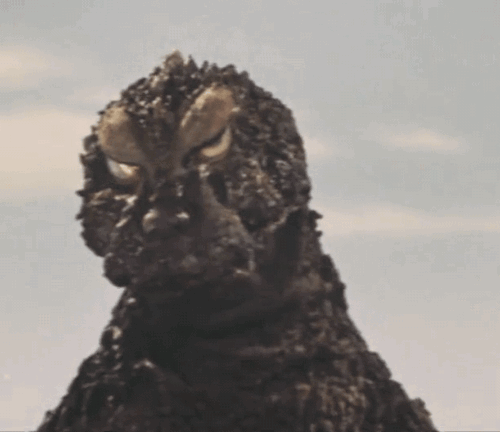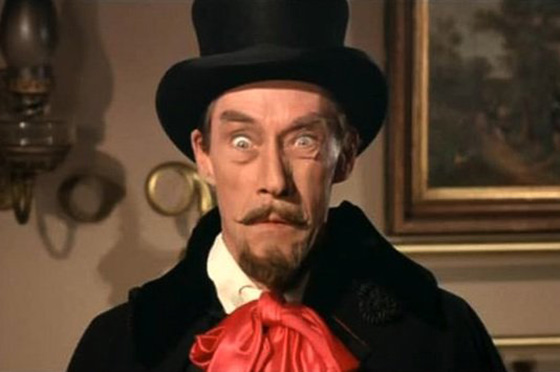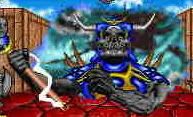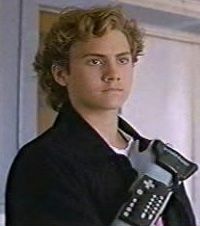|
|
Post by Seth Drakin of Monster Crap on Jun 10, 2008 20:07:29 GMT -5
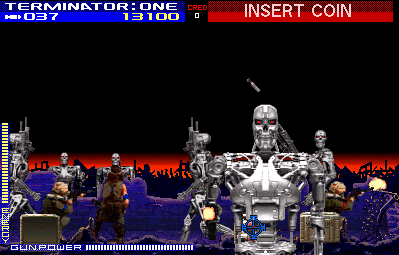 126. Terminator 2: Judgement Day Terminator 2: Judgment Day is the name of an arcade game released by WMS Industries (the owners of the Williams and Midway brands) in 1991. The game is loosely based on the film of the same name. The home console versions are called T2: The Arcade Game to avoid conflict with the platform games. Arnold Schwarzenegger provided custom speech for this game. The story of the game falls in line with the movie Terminator 2: Judgment Day: to save the leader of the Human Resistance, John Connor, and his mother, Sarah, from the T-1000, a mimetic poly-alloy Terminator, bent on killing them both. The first mission is actually a backstory on what happened before the T-800 and the T-1000 entered Skynet. It also showed some of Skynet's machines that didn't appear in the film (for example, the Silverfish). Running on the once-popular Williams/Midway Y Unit arcade hardware, the 2 players essentially take part in controlling a T-800 model and gun down the terminators of the opposing side in a light gun style fashion, even though the controller was technically a joystick. The gameplay utilizes a first-person perspective, like the rest of the games in the genre, but what was noteworthy about T2 was the use of digitized actors from footage specially shot during the making of the film. This made for realistic 2D sprites in a Light gun game for the time. Arnold Schwarzenegger, Robert Patrick, and Eddie Furlong all reprised their respective roles for the making of the arcade game. Linda Hamilton does not play Sarah Connor in any footage of the game and is instead played by Debbie Evans. In the demo sequence, the game has been rated "R" (for Righteousness) by the Motion Picture Gaming Association of America. |
|
|
|
Post by Gopher Mod on Jun 10, 2008 20:08:51 GMT -5
Sorry but this list is already Crap when MK 4 and Primal Rage outrank 3rd strike. Well then, did anyone else outside of me vote for 3rd Strike? |
|
|
|
Post by Seth Drakin of Monster Crap on Jun 10, 2008 20:17:39 GMT -5
Countdown Update:
150. Arch Rivals
149. Star Trek: Strategic Operations Simulator
148. Street Fighter III: 3rd Strike
147. Super Off Road
146. Primal Rage
145. Moon Patrol
144. Mortal Kombat 4
143. Submarine
142. Big Buck Hunter
141. Toki
140. Vs. Baseball
139. San Francisco Rush
138. Sunset Riders
137. NBA Jam
136. Golden Tee Golf
135. WWF Wrestlemania
134. Hogan's Alley
133. CarnEvil
132. Kung Fu Master
131. Berzerk
130. Tekken 5
129. Puzzle Bobble aka Bust A Move
128. Time Traveler
127. 3 Count Bout
126. Terminator 2: Judgement Day
That is all for today. Tomorrow, we see who made the Top 125.
Here are the clues to the next five games.
* A Circus Clown Being Chased By Mini-Dinos
* Defeat Red Skull At His Moon Base
* Play 100 Meter Dash, Long Jump,, Javelin Throw, 110M Hurdles, Hammer Throw, & High Jump
* Play As A Knight Either On An Osterich Or A Stork
* Rescue Melissa And Bring Forth The Downfall Of The U.R.D.A.
|
|
Johnny Danger (Godz)
Wade Wilson
loves him some cavity searches
Lord Xeen's going to kill you.
Posts: 27,736
|
Post by Johnny Danger (Godz) on Jun 10, 2008 20:19:15 GMT -5
Joust, Track and Field, and The Avengers I know...
|
|
|
|
Post by Seth Drakin of Monster Crap on Jun 10, 2008 20:28:43 GMT -5
Sorry but this list is already Crap when MK 4 and Primal Rage outrank 3rd strike. Well then, did anyone else outside of me vote for 3rd Strike? Let me state that there is a difference between Street Fighter III and Street Fighter III 3rd Strike. |
|
|
|
Post by Gopher Mod on Jun 10, 2008 20:32:22 GMT -5
Well then, did anyone else outside of me vote for 3rd Strike? Let me state that there is a difference between Street Fighter III and Street Fighter III 3rd Strike. Was that directed towards me? I'm a bit confused right now. |
|
|
|
Post by Seth Drakin of Monster Crap on Jun 10, 2008 20:55:00 GMT -5
Let me state that there is a difference between Street Fighter III and Street Fighter III 3rd Strike. Was that directed towards me? I'm a bit confused right now. No it was mostly directed towards the other guy who said it was crap, but it was somewhat directed towards you as well so we could resolve this issue. |
|
|
|
Post by Gopher Mod on Jun 10, 2008 21:06:33 GMT -5
Yeah. 3rd Strike was quite a bit of a different beast than the original, SF3: New Generation.
|
|
|
|
Post by Hypnotix on Jun 10, 2008 23:37:18 GMT -5
 128. Time Traveler I own this on the PS2. I bought it used for $1.99 and it even had the 3-D glasses included. Its a horrible game, but my friends and I bust it out when we need something horrible to laugh at. I can't believe it made this list. |
|
|
|
Post by Seth Drakin of Monster Crap on Jun 11, 2008 8:49:34 GMT -5
 125. Mr. Do! Mr. Do! is an arcade game created by Universal in 1982. Similar in gameplay to Namco's popular Dig Dug title, Mr. Do! was also popular and saw release on a variety of home video game consoles and systems. It is the first game in the Mr. Do series, and was released both as a standalone game and as a conversion kit (released by Taito Corp.) for existing arcade cabinets. The object of Mr. Do! is to score as many points as possible by digging tunnels through the ground and collecting cherries, which are distributed throughout the level in groups. The title character, Mr. Do (a circus clown) is constantly chased by monsters called Mini-Dinos, and the player loses a life if Mr. Do is caught by a monster. Mini-Dinos can be defeated by hitting them with a bouncing ball or by dropping large apples on them. Occasionally, Mini-Dinos transform briefly into slower, more powerful enemies that can tunnel through the ground. The game is over when the player runs out of lives. Occasionally during play, a letter from the word "EXTRA" appears on the playfield as a monster, and the player can defeat this monster in the same way as a Mini-Dino. Defeating a letter monster awards that letter, and collecting all the letters of the word awards an extra life. Rarely, a diamond will appear on the playfield which, when collected, awards a bonus credit to the player, allowing him or her to play an extra game. (This feature is relatively unique among arcade video games, though it is a standard feature of most pinball machines.) |
|
|
|
Post by Seth Drakin of Monster Crap on Jun 11, 2008 8:55:47 GMT -5
 124. Crisis Zone Crisis Zone is a spin-off of the popular Time Crisis arcade shooters. In Crisis Zone, the player is part of the elite Anti-Terrorist trooper of the Special Tactical Force (STF), Claude McGarren. The game uses the same pedal system to reload and hide; however, the player uses a machine pistol, a customized Steyr Mannlicher TMP with a Laser Aiming Sight and a capacity of 40 rounds. Players take cover behind a portable riot shield that is strapped to the character's left arm. Crisis Zone is the first Time Crisis game to date to allow the player to select between three levels to play in any order. Upon completion of all three of them, the player can then play the final level to beat the game. A PlayStation 2 (PS2) port of the game was released in 2004 with smoother polygon textures, higher difficulty, and an additional mission taking place six months after the Crisis Zone Arcade mode. The PS2 port was titled Time Crisis: Crisis Zone in the North American release and is compatible with the GunCon 2 lightgun. Garland Square recently opened on the outskirts of London. This urban complex contains hotels, a mall, a park, and an office complex. Unfortunately, the entire facility has been overrun by a terrorist organization known as the U.R.D.A., headed by Derrick Lynch. The terrorists have made no demands, neither they have any motives. Facing an unknown threat, the government thus concludes that the U.R.D.A. must be stopped at all costs and Lynch must not be allowed to execute his hidden agenda, whatever it may be. With the aforementioned in mind, the Special Tactical Force has been ordered to liberate Garland Square and suppress the U.R.D.A. Squad 1, the task force responsible for the liberation of Garland Square, is led by Claude McGarren. Although heavy resistance was imminent throughout the complex, Squad 1 secured the area although Lynch was not visible. STF Headquarters than receives disturbing information about Lynch's goal of "over-working" an experimental atomic reactor 5km below the complex. McGarren and Squad 1 engaged in a tense time-sensitive conflict to nullify Lynch and to prevent the reactor from becoming unstable, ultimately saving the security of London. Six months after the Garland Square incident, new U.R.D.A. mastermind Jared Hunter hijacks Grassmarket District and as an insurance policy, has Melissa Kessler (the S.T.F. Commander's daughter) in custody. Although Hunter's demands include but not limited to the release of his comrades in exchange for the complex's freedom, he is seeking revenge against the S.T.F. platoon (Squad 1) for ruining the organization's plan of attack at Garland Square. McGarren and Squad 1 engage in a liberation coup de grace to rescue Melissa and bring forth the downfall of the U.R.D.A. The platoon got into a rough start, having to contend with a droid called the A-0940. Afterwards, McGarren and Squad 1 had either minor or no problem reaching Melissa. Hunter provokes Squad 1 into a fight on top of Belforte Hotel's pool area with Squad 1 coming as the victor. As Hunter attempts to escape, McGarren engage in an air-to-sea chase to crush Hunter and ultimately secure Grassmarket. |
|
|
|
Post by Seth Drakin of Monster Crap on Jun 11, 2008 8:57:59 GMT -5
 123. Captain America and The Avengers Captain America and the Avengers is the title of a beat 'em up coin-op arcade game released by Data East in 1991 based on the Marvel Comics' series The Avengers. Players can choose to play one of four superheroes - Captain America, Iron Man, Hawkeye, or Vision - as they battle through New York City, the underwater world of Atlantis, and eventually into Red Skull's moon base, which has a giant laser cannon pointed at Earth for destruction. The game comes in both two and four-player cabinets. In the two-player version, each player chooses the character they want to play whenever they start or continue. In the four-player version, each character is assigned a specific coin slot and set of controls. The program can be switched between two and four-player modes via a dip switch setting. Gameplay is similar in format to the Teenage Mutant Ninja Turtles beat 'em up arcade games, as well as other beat 'em up arcades developed by Konami. Each character can attack and jump, and also pick up and throw certain objects positioned in each level, i.e. bricks or barrels. Attacks are accompanied by comic book-style sound effect words such as "THWAK!," "WHAM!," "KABOOM!," "KRAK!," etc. Each character also has a special projectile attack, and the ability to block certain shots. The players battle their way through hordes of relatively weak enemies who die after only a few hits, then must face and defeat more powerful boss characters at the end (and sometimes in the middle) of each level. The boss characters in the game include Klaw, The Living Laser, Whirlwind, the Wizard, the Grim Reaper, the Mandarin, The Juggernaut, Ultron, Crossbones, and Red Skull. Other Avengers such as the Wasp, Quicksilver, Wonder Man and the Sub-Mariner make cameo appearances. Interestingly, the giant robot seen in the second stage resembles either the Sentinels or Master Mold. Some of the dialogue was mistranslated. One example is during the battle against Klaw and the Living Laser, where in response to the villains' demand, "Don't disturb us", the player's character replies "Why should it goes well?" |
|
|
|
Post by Seth Drakin of Monster Crap on Jun 11, 2008 9:01:03 GMT -5
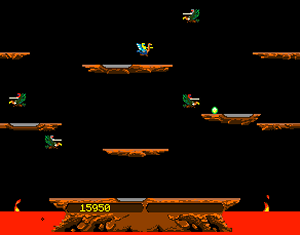 122. Joust Joust is an arcade game produced by Williams Electronics in 1982. The player takes the role of a knight with a lance, mounted on either an ostrich (player 1) or a stork (player 2), battling waves of computer-controlled enemy knights. The enemy knights have three different speed and agility levels and are mounted on giant buzzards. The game screen is static; its only features are five platforms hanging in mid-air (some wrapping around the screen), the ground, and a pit of lava below. The game's incredibly simple controls are a factor in its wide appeal. A joystick moves left and right, and a "Flap" button flaps the mount's wings once. Pressing "Flap" in rapid succession will cause a gain in altitude until gravity drags the player downward. Each wave begins with enemy knights appearing on the screen at one of four "spawn points." To destroy an enemy knight, the player has to collide with the knight while his lance is vertically higher than the enemy knight's lance. After destroying an enemy knight, a giant egg will appear and fall, bouncing on the ground. The player has to go touch (and thus destroy) the egg, gaining additional points; if this act takes too long, the egg will hatch and another, more powerful enemy knight will appear and continue the fight against the player. The three types of enemy knights, from weakest to toughest, are Bounder (red knight), Hunter (white knight) and Shadow Lord (blue knight). A wave is cleared when the player destroys all enemy knights and eggs. If too much time elapses on a particular wave before this occurs, the dreaded pterodactyl will appear from one side of the screen and fly around until it collides with the player, destroying him; until the player finishes the wave; or until the player destroys the pterodactyl by hitting it directly in the mouth with his lance, a difficult task, due to its incredible speed when attacking. Two players can play Joust, and each player will get points for destroying the enemy knights, and also for destroying his human opponent. Cooperative play is possible by agreement between the players, but they can still kill each other accidentally if they collide. Some rounds award bonus points if the two players successfully avoid killing one another, other rounds encourage the players to kill each other by offering a bonus to the first player to do so. A lava troll inhabits the lava pit at the bottom of the screen; if any player or enemy knight flies too close to the lava, the troll's hand will emerge and tug the mount downward toward the lava. Players can get out of the troll's grip by hammering on the "Flap" button. During the first two waves a temporary floor covers the lava pit, which is burnt away at the beginning of the third wave. The troll seems not to exist during the third wave. SCORING Killing enemies: * Bounder (Red): 500 points * Hunter (Silver/Gray): 750 points * Shadow Lord (Blue): 1,000 points * Pterodactyl: 1,000 points * Getting killed: 50 points * Picking up eggs or hatchlings: 250, 500, 750, or 1,000 points (progressive). The progression starts again when the player is killed or starts the next wave. * Picking up an egg before it touches the ground: 500 points * Completing a Survival Wave without dying: 3,000 points * Completing a Team Wave without either player killing the other (Two players only): 3,000 points for each player. * Being the first player to kill the other player during a Gladiator Wave (Two Players only): 3,000 points One "bug" in the program's design became a strategic advantage to players in the know, later touted by producers as a "hidden feature". On the right side of the screen there are two platforms situated so that one is above and slightly overhangs another. If a player moves across the lower of the two platforms, the player will hit the upper one and be halted. However, if a player flies their bird so that its belly skims the lower platform low enough that its legs do not extend, the bird will "belly flop" across the width of the platform, and, illogically, "squeeze" through the meeting point of the two platforms, shooting out below the upper platform. Skilled players took advantage of this flaw as a gaming strategy: a player could suddenly pop out below the platform and land on an enemy knight below (or a competing player), catching him by surprise. Game creator John Newcomer stated in interviews that this flaw in the game's design was so popular, they decided to intentionally leave it in and it became a permanent part of the game. Early ROM revisions of the game contained a situation which a skilled player could exploit to accumulate an infinite number of points on certain waves, with low risk. The player would attempt to maneuver one of the enemy knights too close to the lava, such that the lava troll would grip it - not low enough to the lava so the troll would succeed in pulling it in, and not high enough so the enemy knight could escape the troll's grip. By doing so, the knight could never attack the player and distract him from performing the trick, and the wave would also never end. Then the player would stand in the middle of the platform in the center of the screen. The pterodactyl would appear from one side below the player and charge right at him; if the player simply stood in the middle of the platform, facing the pterodactyl, the player's lance would strike the pterodactyl in the mouth, killing it. Pterodactyls would appear at an increasing rate from different sides of the screen, with a maximum of 3 present on the screen at any time, and could be killed in the same manner. This could be repeated indefinitely, scoring large amounts of points and extra lives. Arcade game operators were not too happy seeing players exploit such a bug. |
|
|
|
Post by Seth Drakin of Monster Crap on Jun 11, 2008 9:04:26 GMT -5
 121. Track & Field Track & Field is the name of a series of Olympic themed video games developed by Konami for several platforms since 1983. The first title, simply called Track & Field (Hyper Olympic outside the United States) was released in 1983 as an arcade game. The simple gameplay, based on quick, repeating, button presses set the basics for sequels and similar games in the genre for the next decades. There were several home versions of the original; note that the ZX Spectrum and Amstrad CPC versions were only released as part of the Game, Set and Match II compilation in 1988, and are poorly regarded by fans. The NES version was especially well-received and big-selling. In the original arcade game, the player uses two "run" buttons (or a trackball in some early units) and one "action" button to control an athlete competing in following six events: * 100 Meter Dash – Running by quickly alternating button presses. * Long jump – Running and correct timing for jump. Hold jump button to set angle. * Javelin throw – Running and then using action button correct timing for angle (~42 degrees is optimal). * 110m Hurdles – Running and using action button to time hurdles * Hammer throw – Spinning initiated by pressing a run button once and then correctly timed press of action button to choose angle (45 is optimal). * High jump – Running and then action button must be held down to determine angle of jump. Once in the air, the run button can be rapidly pressed for additional height. In each event, there is a qualifying time or level that the player must achieve to advance to the next event; failing to qualify (in one heat for running events or three tries in the other events) ends the game. The game can accommodate up to four players, who compete in pairs for the running events, and individually for the others. If there are fewer than four players, the remaining slots are played by the computer (or player "CPU"). In all multiplayer heats, though, the relative performance of the players has no effect on the game, and advancing is based solely on qualifying times. If a player completes all six events, after a brief medal ceremony he is sent back to the field for another round, with higher qualifying levels. In the follow-up Hyper Sports, there were seven events: 100-meter freestyle, skeet shooting, vault, archery, triple jump, weight lifting and pole vault. |
|
|
|
Post by Seth Drakin of Monster Crap on Jun 11, 2008 9:10:42 GMT -5
Countdown Update:
150. Arch Rivals
149. Star Trek: Strategic Operations Simulator
148. Street Fighter III: 3rd Strike
147. Super Off Road
146. Primal Rage
145. Moon Patrol
144. Mortal Kombat 4
143. Submarine
142. Big Buck Hunter
141. Toki
140. Vs. Baseball
139. San Francisco Rush
138. Sunset Riders
137. NBA Jam
136. Golden Tee Golf
135. WWF Wrestlemania
134. Hogan's Alley
133. CarnEvil
132. Kung Fu Master
131. Berzerk
130. Tekken 5
129. Puzzle Bobble aka Bust A Move
128. Time Traveler
127. 3 Count Bout
126. Terminator 2: Judgement Day
125. Mr. Do!
124. Crisis Zone
123. Captain America and The Avengers
122. Joust
121. Track & Field
Here are the clues to the next five games.
* Escape From A POW Camp
* Kill Pookas & Fygars
* Play As Thor, Merlin, Thyra, or Questor
* Shoot Aliens & Alien Created Zombies
* Simple, Normal, & Hard Chapter
|
|
|
|
Post by Seth Drakin of Monster Crap on Jun 11, 2008 11:35:21 GMT -5
 120. P.O.W.: Prisoners of War P.O.W.: Prisoners of War is a beat 'em up game by SNK. The arcade version of the game is for two players. However in the version ported to the NES, it is just a one-player game. The main character in single player is a captured P.O.W. commando codenamed Snake (Bart in the NES version) who must bomb his way out of a P.O.W. prison cell and escape. They must escape through four levels of gameplay where the mission is not only to escape, but to infiltrate the enemy base and destroy their leaders. There are brass-knuckles, body armor, knives, grenades, and machine guns that the players can use in order to aid them in their mission. There are four levels of gameplay: * First Level: Escape from Prison Camp * Second Level: Attacking the Industrial Area * Third Level: Guerilla Attack in the Jungle * Fourth Level: Destruction of Communications Headquarters P.O.W. is a side-scrolling, beat 'em up game, which were typical during the time that it was created. The game play is simple. For the NES version of the game, the crosspad maneuvers the character in all directions. The 'A' button kicks and if equipped with a weapon it will utilize the weapon. The 'B' button is used for punching and if equipped with a rifle, the player can strike opponents. When both buttons are pressed simultaneously, the player unleashes a powerful flying kick. The usefulness of the punch in the arcade version has been called into question, since it drives the enemy soldier backward, possibly giving him a chance to get away and then return to the fight. In the attract mode in the arcade version, a machine gun becomes available to Snake much earlier than in actual gameplay, a fact that some might say smacks of false advertising. |
|
|
|
Post by Seth Drakin of Monster Crap on Jun 11, 2008 11:38:05 GMT -5
 119. Area 51 Area 51 is a light gun arcade game issued by Atari Games in 1995. It takes its name from the Area 51 military facility. The plot of the game involves the player taking part in a military incursion to prevent aliens and alien-created zombies from taking over the Area 51 military facility. The game takes the player through several sections of the facility, including a warehouse and underground tunnels. The player must kill all of the genetically altered scientists and aliens without harming any allied STAAR team members (at the cost of one life point),however if nothing but three STAAR team members are shot, an alien mode will be started. None of the actual aliens will appear until the office level. The game is notable for its use of digitized video stored on an on-board hard disk, and the bizarrely contrasting unrealistic gibs into which every enemy blows apart when shot, in exactly the same way. While enemies, innocents, and explosions are 2D digitized video sprites, the levels and vehicles are pre-rendered in 3D. Another interesting note about the game is its several "backdoors"; by shooting certain objects in the correct sequence players can unlock shooting exercises, weapon stashes, and gain bonus items that are not available in the main game plot. The game's arcade board, CoJag, is a modified Atari Jaguar with enhanced graphics and sound capabilities. Area 51 allows the players to start at the beginning of the game or warp ahead to the middle of the game. |
|
|
|
Post by Seth Drakin of Monster Crap on Jun 11, 2008 11:42:39 GMT -5
 118. Virtua Cop 3 Virtua Cop 3 is the third game from Sega's Virtua Cop franchise. Virtua Cop 3 is only available in arcades. The game is available in standard and deluxe cabinet formats. Utilizing the Sega Chihiro engine for life-like graphics, Virtua Cop 3 introduces a new slow-motion "bullet time" mechanism which allows players to slow down time with a step of a special pedal. Virtua Cop 3 also allows players to toggle between different weapons instead of having to put up with one weapon. The alternative weapons include the Smith & Wesson Model 629, Benelli M4 Super 90, H&K MP7, and the H&K G36C. Like the previous installments, players progress through the game choosing between three missions which vary in difficulty. The newly designed gun used in the game is named the Guardian II, and was designed by Tokyo Marui, famous for their model guns. Virtua Cop 3 allows players to play the chapters in any order the players desire. Simple ChapterWhen the ECM took over a large pharmacy building, Rage and Smarty were ordered by the VCPD to apprehend the invaders and secure the building. Throughout the pharmacy campaign, Rage and Smarty meets up with a mysterious man known as "Gale", a ninja with unknown intentions. Proceeding deeper inside the pharmacy research lab, Rage and Smarty meets up with a man named "Glitter", who is liable for the invasion. While the Virtua City police secured the pharmacy building, Janet receives disturbing information regarding about the pharmacy's genetic cloning system being missing. Normal ChapterBrand, a bank robber hired by the ECM, robs a large bank in downtown Virtua City. The VCPD Riot Squad is no match for the ECM's munitions, prompting Rage and Smarty to help the disadvantaged riot squad. Once Rage and Smarty spots Brand in the building, a chase ensues, but after Rage and Smarty endured the interference as they make their way out of the building, Gale interrupts them once again. Rage and Smarty survives Gale, pursues the military bank robbers, ultimately being pushed towards the subway where Brand is hiding. The ultimate battle between the Virtua Cops and Brand ensues. Throughout the bank campaign, Janet receives disturbing information that the reason for the ECM's bank robbery was to retrieve a secured package of dinosaur genes. Hard Chapter military base has been seized by the ECM. Rage, Smarty, and Janet make a sneak attack through the sewers before ultimately catching up with the military base. Enduring the heavily-guarded area, the three make it inside the hangars where a crab-like vehicle provocates the three to a life-or-death duel. The pilot, turning out to be Joe Fang, shows himself. In spite of the aghastness Rage had when he saw Fang, the vehicle was destroyed and the military base is secured. Depending on the players' performance, the player may be asked to participate in a chapter where the behind-the-scenes plot is revealed. First the mysterious ninja Gale challenges the three in a duel inside the hangar, then it continues with the three fighting Joe Fang clones throughout an elevator platform leading to the real body of Joe Fang, in which much of the game's plot becomes revealed. Ultimately, the case is closed and ECM's plot has been recorded on VCPD's file. |
|
|
|
Post by Seth Drakin of Monster Crap on Jun 11, 2008 11:44:52 GMT -5
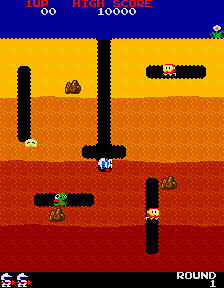 117. Dig Dug Dig Dug is an arcade game released by Namco in 1982 to run on Namco Galaga hardware. A popular game based on a simple concept, it was also available as a home video game available on many consoles. The objective of Dig Dug is to eliminate underground-dwelling monsters. This can be done by inflating them until they pop or by dropping rocks on them. There are two kinds of enemies in the game: Pookas, round red monsters (said to be modeled after tomatoes) who wear yellow goggles, and Fygars, green dragons who can breathe fire. The player's character is Dig Dug, dressed in white and blue, and able to dig tunnels. Dig Dug is killed if he is caught by a Pooka, burned by a Fygar's fire, or crushed by a rock. It takes four 'pumps' with the player's action button to inflate a monster until it bursts. If left partially inflated, the monster will deflate and recover after a few seconds, but half-inflating is a useful way to stun an enemy for a few moments, especially to make sure it remains in the path of a falling rock. You can also pass through the enemy while he is deflating. The monsters normally crawl through the tunnels in the dirt but they can turn into ghosty-eyes and travel slowly through the dirt. More points are awarded for eliminating an enemy further down in the dirt (the levels are color coded), and the Fygar is worth more points if it is inflated horizontally rather than vertically (because it only breathes fire horizontally). More points are also awarded for dropping rocks on enemies in order to eliminate them rather than inflating them. If one enemy is killed by the rock, it is worth 1000 points. The next two add 1500 points each and any after that they add 2000. The act of digging is itself worth points, giving ten points for each block dug, so some players do as much of it as possible in situations where the threat from the remaining monsters is minimal. After the player drops two rocks, fruits and vegetables (and other edible bonus items, such as Galaxian flagships) appear in the center of the playfield, and can be collected for points if the player is able to reach them before they disappear. These edible bonus items will appear even if the rocks fail to hit any enemies. In some versions of the game, the most points you can get for this fruit bonus is 8,000 from the pineapple. If the player drops a rock on a foe at the same time he pumps it to death, the game will be tricked into thinking that all enemies have been destroyed, but that the level has not been defeated. Thus, all enemies will promptly disappear, and the player will be free to dig through all dirt. Until another rock is dropped, going to the next level will remain impossible. The last enemy on a level will try to escape off the top left of the screen. Level numbers are represented by flowers in the top right of the screen and each new level is noted at the beginning of each stage on the bottom right (as seen in graphic above). In successive levels, more monsters appear on each screen and they move more quickly. A level is completed successfully when the last monster is dispatched or succeeds in fleeing. In the coin-operated version the game ends on round 256 (round 0) since this board is unplayable. At the start of the level, a Pooka is placed directly on top of where the player starts, with no way to kill it (this is an example of a kill screen). Although Namco has officially given the character of the original Dig Dug the name "Dig Dug," in other games where he makes an appearance, the protagonist goes by Taizo Hori, and is the father of Susumu Hori, the main character in the Mr. Driller series. He is also the ex-husband of Toby "Kissy" Masuyo, the heroine of Baraduke. His name is a pun on the Japanese phrase "Horitai zo" or "I want to dig." Many American gamers learned of his real name via the (Japan-only) PlayStation 2 game Namco x Capcom and the Nintendo DS game Mr. Driller Drill Spirits, where he is also a playable character. He is additionally featured in an unlockable gallery of Mr. Driller items in Mr. Driller 2. In the Mr. Driller series, Hori is known as the "Hero of the Dig Dug Incident" In Japan, he is also the "Hero of the South Island incident," a likely reference to Dig Dug II), and is the honorary chairman of the Driller Council whom most of the characters answer to. This contrasts greatly with the PC remake Dig Dug Deeper, where the hero is simply named Dig Dug. In this game, he is likely an American; as this game was made by Infogrames and not Namco, so it is not considered canon. |
|
|
|
Post by Seth Drakin of Monster Crap on Jun 11, 2008 11:48:45 GMT -5
 116. Gauntlet Gauntlet is a 1985 arcade game by Atari Games. Gauntlet is a fantasy-themed hack and slash arcade game which can be played by one to four players simultaneously, unique for arcade games of its day. Released during the emergence of popularity of role-playing games like Dungeons & Dragons, the game was a sensation, being the one of the first true dungeon crawl arcade games. Controversy came after the release of this game in the arcade and its subsequent port to the Nintendo NES system. Ed Logg, the creator of Asteroids and Centipede is credited for Original Game Design of Gauntlet in the arcade version, as well as the 1987 NES release version. After its release, John Palevich threatened a lawsuit, asserting that the original concept for the game was from Dandy (later Dandy Dungeon), a game for the Atari 800 computer written by Palevich in 1983. The conflict was settled without any suit being filed, with Atari Games doing business as Tengen allegedly awarding Palevich a Gauntlet game machine. Logg is taken off this credit in versions subsequent to the 1987 NES release. While he is credited as "special thanks" through 1986, his name is entirely removed from credits on later releases. Logg currently claims no involvement in any of the Gauntlet series. The game Dandy which was the basis for the threatened lawsuit was later reworked by Atari and re-published for the Atari 2600, Atari 7800 and Atari XE as Dark Chambers in 1988, subsequent to the release of Gauntlet II in 1987. A player may control either Thor the Warrior, Merlin the Wizard, Thyra the Valkyrie or Questor the Elf. The hero being controlled is dictated by the player's position on the cabinet. (There is only one of each hero.) Each hero has a unique specialty/advantage: The Warrior is strongest in hand-to-hand combat, the Wizard has the strongest magic, the Valkyrie has the greatest armour and the Elf is the fastest in movement. Players must cooperate to traverse the perils of a dungeon via a top-down view. The game has no actual goal. The only way to stop playing is to either die, or wait for the health timer to go down to zero. The NES version does, however, have an end (after 100 levels). The players traverse the dungeon levels controlling their assigned heroes, attacking monsters and collecting treasure, food, and potions. The monsters of the first Gauntlet game included ghosts, grunts, demons, lobbers, sorcerers, and thieves. Each kind of monster was generated in specific houses spread in each level. A special enemy, "Death", was able to drain the life force of the four heroes. The players must cooperate by sharing food and luring monsters into places where they can be engaged and slaughtered more conveniently. The heroes continuously lose health during gameplay, regardless of what they are doing — even if they are just standing still. Heroes lose even more health when attacked by monsters. Besides finding food in the dungeon, players can add health by depositing more coins. Hence, Gauntlet was notorious for being a money gobbler when it first appeared, since players desperately shoved in handfuls of coins in order to avoid being ejected from the game and sometimes waiting hours in line in order to play again. One of the game's features was the narrator's voice. He would frequently make statements repeating the game's rules, including: "Shots do not hurt other players (yet)," "Remember, don't shoot food!" and "Warrior needs food -- badly!" Occasionally, the narrator would encourage (or mock) the players in the thick of battle by saying, "I've not seen such bravery!" or "Let's see you get out of here!" A memorable statement of the game occurred when a player's "life force" points fell below 200: "Your life force is running out" or "Valkyrie...is about to die!" Some of the game's statements are humorously ambiguous due to limited memory, such as "You are full of bombs and/or keys." Due to the fact that Gauntlet was designed for up to four players, the cabinet is wider than other standard uprights. Each player had a joystick and two buttons, one for "Fire" (to attack) and one for "Magic". The Magic button also started the game. After Gauntlet's release, other games started using this design, so it was a popular conversion target for newer games after it had its run. The historic influence of Gauntlet can be seen in later dungeon crawler games such as Cadash, Dungeon Explorer, Dark Seal, and Diablo. Though by no means was Gauntlet the only influence on these games, it clearly left a mark on them. For Atari ST and Amiga, a direct Gauntlet clone called Garrison was produced. Gauntlet also has a place in pop culture (specifically '80s video gaming culture). Quotes from the voiceover announcer such as "Wizard needs food badly!", "Valkyrie shot the potion!" and "Elf shot the food!" are some lines from the game that became popular with video arcade patrons and later with nostalgic Internet users, similar to all your base are belong to us or the dog from Duck Hunt. Because of this popularity and the designers' nostalgia for the older games, such lines have been included in the more modern Gauntlet sequels. The line "Elf needs food badly!" was named the third best game line ever in the January 2002 issue of Electronic Gaming Monthly. When playing as a Wizard, Elf, or Valkyrie race/class in NetHack, the player receives warning messages about becoming weak from hunger or running low on hitpoints: "... needs food, badly!" or "... is about to die!" respectively. |
|


